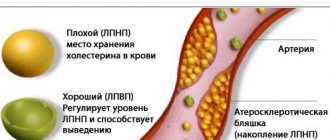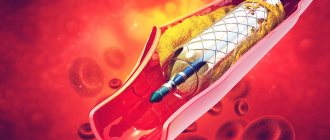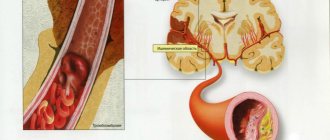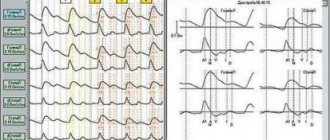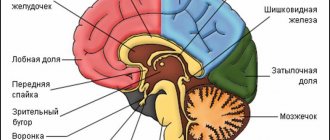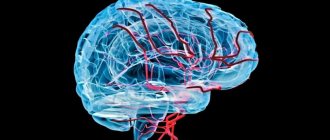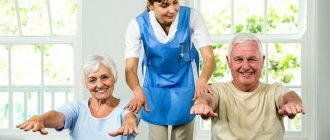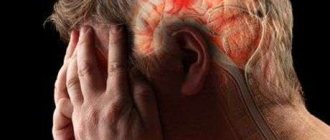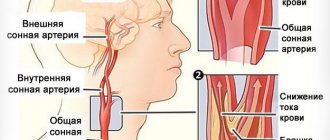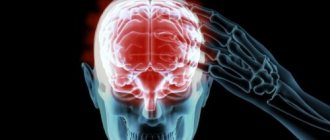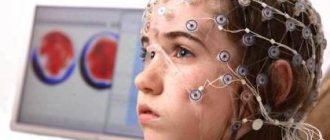Patient's menu after a stroke
After a severe hemorrhagic or ischemic circulatory disorder of the brain, the patient’s ability to swallow food is often impaired. Before the first feeding in the hospital, the patient is given a teaspoon of boiled water in order to test the swallowing reflex.
If swallowing is impaired, the patient either refuses food or the food comes out of the mouth. In such cases, feeding is carried out using a gastric tube. Through a special device, liquid homogeneous food is directly introduced into the stomach. The menu for tube feeding includes vegetable soups, broths, juices, tea, to which the necessary vitamins and microelements are added.
If swallowing is normal, the patient continues to be fed liquid food in small portions. The menu in the first days consists of pureed purees, homogeneous broths, jelly, and liquid porridge. After improving the swallowing reflex, steamed cutlets, vegetable salads, and soft-boiled eggs are added to the patient’s diet.
Methods of feeding bedridden stroke patients
A severe stroke leads to the fact that the patient is initially unable to chew, and swallowing is also impaired. For several days, nutrition during a cerebral stroke occurs parenterally, that is, with the help of droppers. Subsequently, tube feeding is used until the swallowing reflex is restored.
The end of the gastric tube is lubricated with Vaseline and slowly inserted through the nose. The main condition is that the probe gets into the esophagus and not into the respiratory tract. The correct direction of the probe can be verified if the patient does not start coughing and choking. A funnel must be inserted into the upper part of the probe, through which warm liquid food is fed in small portions. You can feed through a tube:
- fruit juices with pulp;
- liquid dairy products;
- broths;
- vegetable soups pureed in a blender;
- special mixtures for enteral nutrition.
If the patient is lying down, but can already swallow independently, he is fed in bed, giving his head and back an elevated position. Food is given from a spoon, and a straw is used to drink drinks.
What can you eat if you have a stroke, as soon as swallowing is restored? At first - only liquid dishes. Then mashed potatoes, steamed cutlets, soft-boiled eggs, and fresh vegetable salads, grated on a fine grater, are added to the diet.
In the first month, the patient may noticeably lose weight, but this is not always bad, for example, if before the illness there were a lot of extra pounds.
When a person is forced to lie in one place, he perceives his condition very painfully and, despite progress in treatment, may refuse to eat at all. An increased level of stress also occurs because you can’t eat your favorite foods, and your taste buds don’t work as they should at first. In such cases, nutrition during a cerebral stroke can be occasionally varied by adding 1-2 favorite sweets or a small piece of fried meat to the menu.
Ischemic stroke is a serious pathology of the cardiovascular system, which develops as a result of a decrease in blood supply to the brain in a certain arterial area. This condition can lead to both disability and death.
To prevent relapse, it is very important to follow a special therapeutic diet. That is why it is very important to know what you can eat after a stroke and what is not recommended.
Diet and diet in the first days
The patient's nutrition is strictly controlled by the doctor. In the first days, concomitant diseases are especially taken into account. So, for diabetes mellitus, a diet that limits the consumption of sugar, fatty and salty foods is indicated. In case of renal or liver failure, a special medical nutrition table is prescribed. If the patient has atherosclerosis, the menu includes foods rich in potassium.
After a stroke, the following are excluded from the menu:
- salty, fried, fatty foods are the main enemies of stroke. When consumed regularly, cholesterol plaques form on the walls of blood vessels, preventing proper blood flow. In the first days after an attack, it is recommended to completely eliminate salt.
- smoked meats - contain a large amount of hidden fats and salt, which burden the liver and excretory system.
- soups and broths made from fatty meat. Instead, you should include skinless poultry in your diet, which helps restore proteins in the body that are necessary to nourish the brain.
- full-fat sour cream, natural and condensed milk containing sugar and fats.
- baked goods and puff pastry products - carbohydrates cause the release of insulin into the blood, as a result of which the heart rate increases, blood rushes to the brain, worsening the patient’s condition. They contribute to weight gain, which is unacceptable after a stroke.
- canned food - contains a lot of chemicals, sugar, salt, dyes and vinegar.
- any types of mushrooms are considered heavy foods due to their high chitin content. They are digested slowly in the stomach and may contain harmful substances even after heat treatment. Interferes with the absorption of healthy foods.
- Semi-finished products - usually made from low-quality raw materials. They contain many flavor enhancers, salt, and preservatives for a long shelf life.
Giving up your usual diet can be very difficult, but it is necessary to restore the body after a stroke, and also prevents a new attack.
Post-stroke diet menu
In 1923, the Institute of Nutrition was created in the Soviet Union. One of the initiators of its foundation was the therapist M.I. Pevzner, whose recommendations on dietology and clinical gastroenterology are still the basis for the development of the post-stroke menu “Dietary Table No. 10”.
Goal: reducing and stabilizing high blood pressure, restoring and normalizing the functioning of the cardiovascular system, preventing the formation of blood clots, thinning the blood.
Calorie content: 1900–2500 kK.
Energy value and chemical composition of the daily diet:
- complex carbohydrates - 350–450 g;
- proteins - up to 100 g (60% - animals);
- healthy fats - up to 70 g (up to 50% - vegetable);
- salt - up to 3 g (only in the post-acute period);
- pure water - up to 1200 mg.
Cooking technology: boiling, steaming, baking, grilling.
Temperature of served food: any (both hot and cold food are allowed).
Features: salt-free recipes; lack of animal fats; five meals a day in fractional portions (120–150 g).
Options for replacing regular foods with dietary ones:
- Butter, lard, etc. are vegetable oils.
- Fatty cheeses - Tofu, Gaudette, Ricotta with a fat content of up to 10%.
- Ryazhenka, baked milk, cream - milk with a fat content of up to 1.5%.
- Cottage cheese or curd masses with 9% fat content are the same, but up to 1%.
- Eggs (chicken, quail) - only egg white.
- Fatty meat - tenderloin, balyk, for chicken - meat without skin.
- Potatoes - asparagus, spinach, cabbage.
- Cookies, crackers, chips - rye crackers (wetting with olive oil is allowed).
- Ice cream is frozen natural juices.
- Ready-made sauces, mayonnaise, ketchup - lemon juice.
Healthy ready meals:
- Soups - in light non-meat broths or water, seasoned with cereals or chopped vegetables. Cold beet soups, puree soups, milk soups, gelled soups and okroshka. Season with low-fat yogurt or sour cream, lemon juice, and chopped herbs. Meat and mushroom broths are prohibited.
- Fish - low-fat sea fish, boiled, grilled, steamed. Prepared from whole carcasses, chopped or ground mass. Jelly serving is allowed. Seafood allowed. Smoked meats, salted foods, canned foods, and fish roe are prohibited.
- Meat - lean veal, chicken, turkey, rabbit, beef or pork balyk (tenderloin) - only in the post-acute period. To remove excess fat, the meat must first be boiled and then used for further processing. Cutlets, steamed meatballs, boiled pork, carbonate are allowed. All fatty meats, sausages, dried and dried products, and canned foods are prohibited.
- Bread products, bakery products and baked goods - gray, black, with bran, made from first- or second-grade flour, stale, salt-free. Biscuits, crackers. White bread, puff pastries, pancakes, pancakes, cheesecakes are prohibited.
- Dairy products - in the absence of allergies to casein and milk proteins, low-fat (up to 1.5%) milk, yoghurts, kefir, and cottage cheese are allowed. All fatty dairy products and salty cheeses are prohibited.
- Cereals - almost everything (semolina - sometimes). Puddings, casseroles, porridges. Restriction: pasta, noodles, legume puree.
- Vegetables and fruits - preferably consumed daily, boiled or steamed (less often raw). In acute and post-acute times, pickles, marinades, preserves, and fermented foods are prohibited. Limit: all types of radishes, peas, shallots and green onions.
- Chicken, quail, duck eggs - only boiled whites (no more than 1 per day). In the post-acute period - no more than 1 egg per day in dishes (casseroles, baked omelettes). Fried, soft-boiled, poached eggs are prohibited.
- Drinks - juices, compotes, fresh juices, decoctions, uzvars, green tea. Cocktails with low-fat milk or yogurt. Coffee, cocoa, dark types of tea are prohibited.
- Sweets - jelly, mousse, soufflé, honey, gelled soy candies, dried fruits. Chocolate, biscuits, etc. are prohibited.
Examples of daily menus during different periods of post-stroke rehabilitation
table 2
| Breakfast | Lunch | Dinner | Afternoon snack | Dinner* |
| Cottage cheese. Uzvar | Low-fat yogurt | 1. Vegetable soup. 2. Steamed chicken fillet cutlet. 3. Shredded cabbage with olive oil. 4. Natural juice | Apple | 1. Steamed mackerel fillet (with lemon juice). 2. Cooked brown rice. 3. Fresh grated carrots |
| Cottage cheese casserole. Green tea | Banana | 1. Fish soup with rice. 2. Salmon fillet on a vegetable bed. 3. Vinaigrette. 4. Cherry jelly | Tea with rosehip. Rye cracker | 1. Steamed turkey meatballs. 2. Buckwheat porridge. 3. Cucumber salad |
| Chicken egg omelette. Weak black tea | Apple. Galette cookies | 1. Green borscht. 2. Beef pork on a bed of vegetables. 3. Boiled beets. 4. Fresh orange | Plum jelly. Unleavened cracker | 1. Beef veal stroganoff. 2. Couscous. 3. Greek salad with tofu cheese |
* - dinner should end 3 hours before bedtime.
The menu we offer is an opportunity to analyze, supplement and improve the dishes indicated in the table, but one rule must remain unchanged - the products must be fresh, varied, as healthy as possible and... inexpensive. Replace the very expensive salmon fillet with economical pollock, bake it on a bed of broccoli and sprinkle with lemon juice - the patient’s body will receive the necessary beneficial acids, vitamins and phosphorus, and you will save the family budget from exorbitant expenses.
Video - Nutrition after a stroke
The first step... The first word... Yes, sometimes people who have had a stroke learn to live again, and it’s hard for their relatives. But patience, work, care, love and adherence to a rehabilitation diet are the path that will definitely lead the patient to recovery and a full, happy life.
Be healthy!
Source: med-explorer.ru
Recommended Products
In addition to those prohibited, the diet after a stroke in the first days includes foods necessary to restore brain and vascular activity.
- Fresh fruits and vegetables - eating them every day helps saturate the body with natural fiber and vitamins that can cleanse the body of waste and toxins.
- Omega-3 fatty acids – very quickly reduce cholesterol in the blood. Contained in rapeseed, olive and soybean oil, as well as in sea fish (mackerel, salmon, tuna).
- Vitamin B – rids the body of homocysteine, which increases the risk of recurrent stroke. A lot of vitamin B is found in beans, sunflower seeds, walnuts, spinach, and wheat germ.
- Carrots – in the first days it is recommended to consume them after heat treatment; during the stabilization period, chopped fresh carrots are very useful.
- Fermented milk products, yoghurts - promote the absorption of food, enhance intestinal function, and relieve constipation.
- Green tea is not only a source of antioxidants, but also helps reduce intoxication in the body.
- Pure water thins the blood and has a beneficial effect on digestive processes.
Healthy eating can be not only healthy, but also tasty. To diversify the taste, you can add natural spices and herbs to your dishes that do not contain calories or irritants.
Sample menu for every day
Despite the fact that many foods for stroke patients are prohibited, you can feed the patient varied and tasty. When drawing up a menu, you need to take into account the wishes of the patient, on which day, which of the allowed dishes, he wants to eat. Monday:
- breakfast - boiled eggs, stewed vegetables, rosehip decoction;
- snack – low-fat cottage cheese;
- lunch – cabbage soup with sour cream, buckwheat porridge with boiled meat, tea;
- second snack – fresh fruits, berries;
- dinner - rice with vegetables, baked fish, cocoa with biscuits;
Tuesday:
- breakfast - cottage cheese casserole with pumpkin, steamed protein omelette, fruit juice with biscuits;
- snack – baked apple with cinnamon, nuts;
- lunch - chicken soup with squash, fresh cabbage salad with cucumbers, dressed with olive oil;
- second snack – nuts, dried fruits, yogurt;
- dinner – fish balls with buckwheat, salad with tomatoes, bread, compote.
Wednesday:
- breakfast - oatmeal with milk with a piece of butter, tea with milk, bread;
- snack – stewed eggplant, bread.
- lunch – chicken soup with cauliflower, boiled breast, mashed potatoes, fruit juice;
- second snack – jelly with cookies;
- dinner - steamed turkey cutlets with zucchini, fresh cabbage salad, cocoa.
Fight constipation
After a stroke, bowel function becomes more difficult. To prevent constipation, the patient should be given proper nutrition. To do this, among food products there should be those that contain large amounts of fiber and organic acids, and thereby improve intestinal motility.
- Ryazhenka, yogurt;
- Dried apricots and prunes (in the form of puree);
- Mashed fresh vegetables and fruits;
- Mineral water enriched with carbon dioxide;
- Honey.
In the absence of a positive effect of such nutrition in the hospital and at home, they resort to enemas and laxatives.
How to create a diet after ischemic hemorrhage
- Reducing caloric intake. In the acute period, the calorie content of the diet decreases, but without reducing its nutritional value. The approximate calorie level is 2500 kcal.
- Multiple meals. After a stroke, you should eat food more often than before the crisis - 4-6 times a day and in small portions, observing the principle of “three dissimilar components”. Each meal can include up to three different components, for example, you can eat soup seasoned with sour cream with a piece of bread, but if the soup comes with meat, then you will have to give up the bread; or eat porridge with butter and fish, but without salad. In the evening you should eat 3 hours before bedtime and this meal should be very meager.
- Liquid and semi-liquid consistency of food. It is better absorbed by the body of a sick person and is easier to swallow. But it is necessary to keep in mind that some food products may not be compatible with certain medications. Check with your doctors about which medications you can take with meals and which ones only after or before meals.
- Refusal of salt. When salt enters the body, it absorbs liquid, thereby causing blood pressure to go through the roof. After a recent stroke, this is absolutely unacceptable. And only after the patient’s condition has normalized, salt can be gradually returned to the diet.
- Limited sugar intake. The maximum daily dose is 50 g, including sugar present in food products.
- Weight control. You need to weigh yourself once a week. If the arrow shows more and more, then you need to reconsider the calorie content of the menu. Remember that it is easier to lose 1-2 kg than 10, especially if you cannot exercise.
- Sufficient amount of fiber. Fiber helps cleanse the body and is a good preventive measure for constipation. There is a lot of fiber in wheat bran, apples, dried apricots, prunes, seaweed, and raisins. Mineral water, fermented baked milk and yogurt also improve peristalsis.
- The basis of an anti-stroke diet is vegetables and fruits. Those who have suffered an ischemic stroke should eat 400 grams daily. vegetables and 300 gr. fruits, and it is healthier to eat them fresh, without subjecting them to heat treatment.
In the first days and weeks after a stroke, the body does not need to be overloaded with digesting food, so it is worth offering the patient liquid and easily digestible food. These can be liquid vegetable soups put through a blender, porridge, purees, etc. Also, the diet must include thermally unprocessed vegetables and fruits (also pureed).
During the period of remission, the diet expands significantly and the person can afford to return to normal life. A list of permitted and prohibited foods and knowledge of nutritional principles will help you create a diet. We offer you a daily menu.
We offer a list of products that help restore vitality after a stroke. They should be included in the daily post-stroke diet:
- Meat – lean beef and veal, turkey, rabbit, chicken breast. You need to cook meat correctly: bake and boil. The following should be excluded from the diet: any fried meat, lard, poultry skin, liver, kidneys, sausages and smoked meats.
- Fish - cod, flounder (also boiled or steamed), in rare cases herring, tuna, mackerel, sardines and tuna. You will have to give up any fried, smoked and salted fish and caviar.
- Dairy products - curdled milk, milk, kefir, low-fat cottage cheese and cheese, sometimes processed cheese is allowed. It is recommended to avoid all fatty dairy products and condensed milk.
- Desserts - sweets based on sweeteners, pudding, jelly, dried fruits, sherbet, jelly, sometimes you can pamper the patient with marshmallows and marmalade. You will have to give up sweets and cookies, muffins and biscuits, chocolate and ice cream.
- Drinks – freshly squeezed juices diluted with water, compotes, kvass, weak tea, rosehip decoction, jelly. Strong coffee and tea, cocoa, sugary drinks and soda can be harmful to health. Herbal teas or teas with additives that stimulate cardiac activity - lemongrass, echinacea, eleutherococcus - are also prohibited.
Almost all vegetables and fruits, berries are allowed, but those that are especially useful are:
- Contain potassium (potatoes, bananas, dried apricots, cabbage, carrots, oranges, radishes, figs);
- Reduce cholesterol (apples, beans, cauliflower, grapefruit, garlic);
- Reduce blood pressure (garlic, broccoli, orange and grapefruit juices);
- Fight free radicals (blueberries and cranberries).
If we talk about other food products, boiled potatoes, oatmeal, rice, cereal soups, crackers, sweet cereals, small quantities of pasta, egg whites are allowed (the whole can be eaten only sometimes). Chips, seasonings and spices, GMO products, fried potatoes - these are things that you will have to learn to do without.
Features of food and fluid intake after a stroke
Due to impaired muscle movement after a stroke, you may have difficulty swallowing and chewing on the paralyzed side.
If it is difficult to swallow, then it is recommended to start eating food pureed or cut into small pieces, but so that both weakened and healthy muscles participate in the chewing process. Those caring for the patient need to constantly remind him to use the muscles on the paralyzed side.
Lying down to feed a person who has had a stroke is not worth it, because... Swallowing in this case will be difficult. It is better to seat non-bedridden patients at the table so that their back is straight and the paralyzed arm does not hang down, but lies on the table above the elbow. This position promotes the natural swallowing process and makes chewing easier.
In the first few days, a sick person may need help: grab a spoon or fork, bring it to your mouth, keep your mouth closed (then the person caring for the patient should be reminded of the tension in the muscles of the lower jaw).
Self-eating will be made easier by proper organization: place plates (preferably unbreakable) on a rubberized napkin, wrap the handles of spoons and forks with cloth or porous rubber, and to make it easier to bring a full spoon to your mouth, change its shape - bend it.
If one arm does not work, and the muscles on the other are weakened, then it is better to drink through a straw at first, and then offer drinks from a cup with two handles. If you have the funds, you can also buy devices for self-feeding: knives for cutting bread with one hand, clamps for plates, etc.
Bedridden patients are fed lying down, but with their heads raised. This is necessary to prevent food from entering the respiratory tract. A napkin or apron is placed on the chest and neck, after which a bedside table with food is placed at a convenient level.
If the swallowing reflex is absent or for some reason a person refuses to eat, food is administered through nutrient enemas through a gastric tube. You can feed both homemade liquid meals and nutritional mixtures purchased at the pharmacy.
Strict adherence to the recommendations of the attending physician regarding dietary restrictions allows you to create favorable conditions for the patient’s body to restore its lost functions as quickly as possible. A properly designed diet menu for stroke, adequate treatment with medications, all this will allow the patient to return to normal life as quickly as possible.
Such a diet can also be considered an effective preventive measure that can prevent stroke or its recurrences.
At first, you may have to be nervous when preparing your daily diet, but gradually the problem with its formation will disappear.
We are ready to offer several menu options for the day.
Breakfast:
- Hercules porridge with milk.
- Buttered toast.
- Weak black tea.
Lunch: Banana.
- Vegetable soup with buckwheat.
- Light sauté with steam cutlet.
- Fresh cabbage salad dressed with olive oil.
- Orange juice (freshly squeezed).
Afternoon snack: low-calorie cottage cheese with berries.
- Pearl barley porridge.
- Cherry tomatoes.
- Fish soufflé in batter.
- Compote.
A couple of hours before you are supposed to go to bed, you should drink a glass of low-fat yogurt.
Breakfast:
- Cottage cheese casserole.
- Fruit jam.
- Green tea.
- A glass of low-fat yogurt.
- Bran bread.
- Beetroot soup.
- Light sauté with steam cutlet.
- Fresh vegetable salad seasoned with lemon juice and olive oil.
- Kissel.
Afternoon snack:
- Herbal decoction.
- Galette cookies.
- Buckwheat porridge.
- Fresh carrot salad.
- Chicken breast chop.
- Fruit jelly.
About two hours before you are supposed to go to bed, you should drink a decoction of rose hips.
When drawing up a menu after stroke, you need to take into account the individual data of the patient. These are age, physical activity, degree of brain damage, and concomitant diseases.
But the main goals of the diet are the same for everyone - lower cholesterol levels, help the heart function.
- Eliminate alcohol, salt and animal fats from your diet. Nutrition in the first few days of a stroke is a salt-free diet, after stabilization of the condition - no more than 5 grams per day. Consumption of fatty foods increases cholesterol, which increases the risk of another stroke by 30%. Alcohol is only allowed in medications.
- Reduce the amount of sugar in your daily menu. Maximum - 50 grams per day, taking into account the content in products.
- Eat 3-5 times a day in small portions. The last dose is 2-3 hours before bedtime. A large or late dinner fills the stomach, and this is an additional burden on the heart.
- Food can be steamed, stewed, boiled, baked. You will have to give up cooking by frying and smoking.
- Calorie content – 2500 kcal per day.
- The total weight of the daily diet is about 2 kg.
- Drinking - 1-1.2 liters per day.
Diet during stroke remission
As soon as the disease subsides and the patient is discharged from the hospital home, he tries to return to his usual rhythm of life. To avoid repeated attacks, the patient should reconsider his habits and diet.
- Smokers must say goodbye to cigarette smoke, no matter how difficult this process may seem.
- Alcohol must be eliminated completely. It not only thickens the blood, but also causes the destruction of blood vessels.
- Obesity is the main enemy of stroke. After suffering a brain stroke, people who are prone to weight gain must follow a strict diet.
- Patients with normal weight also need a new menu. When eating junk food, a weakened body spends a lot of energy on its absorption.
After an ischemic and hemorrhagic stroke, a new nutritional system will help normalize the functioning of the heart and vascular system, and also prevent a recurrent attack.
Recommendations from nutritionists for the duration of compliance
In dietetics, this type of nutrition for stroke patients is called “table No. 10.” Its basis is to reduce the energy value of the diet by reducing the amount of animal fats and carbohydrates. The diet is also prescribed for patients with diabetes.
All dishes must be freshly prepared and warm. If the function of chewing and swallowing is lost, the food is crushed to a liquid puree.
Diet for bedridden patients after a stroke in serious condition - tube liquid nutrition.
It is better to feed the patient in a semi-sitting position, without lying down. There is no need to rush: after a stroke, chewing and swallowing food takes more time. At first, it is better to drink through a straw.
After a stroke, the rehabilitation process follows: it is long, not everyone manages to recover completely. Therefore, following a diet becomes a daily routine for a person who has suffered a stroke.
The patient will have to radically change their lifestyle and eating habits.
- durum wheat pasta;
- potatoes (boiled or baked);
- butter – 20 grams per day;
- drinks – weak tea, cocoa, kvass;
- sugar - up to 50 grams per day, but honey, jam, jam is better;
- legumes - peas, beans.
But the consumption of salt and large amounts of animal fats remains prohibited. Otherwise, the situation may repeat itself with more dire consequences.
Alcohol is completely excluded, but sometimes doctors recommend drinking a glass of natural dry red wine. But the wine must be natural. It is better to consult your doctor on this issue.
To dilate blood vessels, improve blood circulation and restore memory, experts advise adding ginseng to dishes. "Root of Life" stimulates the growth of neurons in the brain.
In order for the body to recover faster, it needs help: strictly follow all the prescriptions of the nutritionist and the attending physician.
Perform feasible physical exercises and exercise therapy complexes every day. And after recovery, we must not forget about the principles of proper nutrition and a healthy lifestyle.
Regimen for taking medications
In the first days after a stroke, the body receives a large dose of medications. In the hospital, specialists monitor nutrition, but what happens after discharge home?
At home, medication and food timings need to be taken into account. These principles are stated in the instructions for the drugs:
- Take before meals;
- Food intake field;
- While eating;
- Compatible with certain products.
Most often, medications are washed down with plenty of clean water. If there is difficulty swallowing, drugs are introduced into the stomach through a tube along with food.
The type of stroke you suffered does not matter. For both ischemic and hemorrhagic disorders, nutrition and diet should be balanced, especially in the first days. Medicines together with diet therapy help to get a patient back on his feet even with complex forms of disorders.
Features of organizing the diet of bedridden patients
There are two types of stroke:
- Ischemic is the cessation of blood supply to some part of the brain, followed by the death of neurons and disruption of the central nervous system. The main reason for the cessation of blood supply is the blocking of the lumen of the vessel by an atherosclerotic (cholesterol) plaque.
- Hemorrhagic is a cerebral hemorrhage caused by a ruptured vessel. Hypertension is considered to be the culprit of such a stroke. The vessel cannot withstand the pressure and ruptures.
The diet after an ischemic stroke involves severe restriction of animal fats, which increase cholesterol levels. After a hemorrhagic stroke, in addition to the above-mentioned fats, salt intake is reduced (it retains water, which increases blood pressure), and the diet is enriched with foods rich in magnesium and potassium.
Stroke in combination with type 1 and type 2 diabetes also requires diet therapy. Diabetes is characterized by a violation of water-salt metabolism, so the most important thing is to adhere to the drinking regime. Diabetes makes the blood more viscous, which can cause another stroke. Therefore, liquid in the form of pure water, compotes and diluted fruit juices is necessary to liquefy it. In addition, foods with high sugar content are removed from the diet.
The main thing is to restore your ability to work and quality of life as quickly as possible. In this case, the diet that a person recovering from an ischemic stroke should adhere to is of great importance.
You need to understand that this type of stroke occurs due to blockage (or narrowing) of the blood vessels supplying the brain.
Cholesterol plaques block blood flow and contribute to high blood pressure and atherosclerosis, so the patient’s menu should reduce the impact of these factors on the body.
This is the absence of animal fats, such as egg yolks and offal, which critically increase cholesterol levels.
The total volume is about two kilograms per day in fractional portions. Drinking regimen – one and a half to two liters of clean water without gas.
